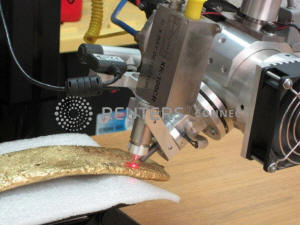Gold bar found beneath Mexico City street was part of Moctezuma's
treasure
 Send a link to a friend
Send a link to a friend
 [January 10, 2020]
MEXICO CITY (Reuters) - A new scientific analysis of a
large gold bar found decades ago in downtown Mexico City reveals it was
part of the plunder Spanish conquerors tried to carry away as they fled
the Aztec capital after native warriors forced a hasty retreat. [January 10, 2020]
MEXICO CITY (Reuters) - A new scientific analysis of a
large gold bar found decades ago in downtown Mexico City reveals it was
part of the plunder Spanish conquerors tried to carry away as they fled
the Aztec capital after native warriors forced a hasty retreat.
Mexico's National Institute of Anthropology and History (INAH) announced
the findings of new tests of the bar in a statement on Thursday, a few
months before the 500-year anniversary of the battle that forced Hernan
Cortes and his soldiers to temporarily flee the city on June 30, 1520.
A day earlier, Aztec Emperor Moctezuma was killed, or possibly
assassinated, according to the native informants of one Spanish
chronicler, which promoted a frenzied battle that forced Cortes, his
fellow Spaniards as well as their native allies to flee for their lives.
A year later, Cortes would return and lay siege to the city, which was
already weakened with supply lines cut and diseases introduced by the
Spanish invaders taking a toll.

The bar was originally discovered in 1981 during a construction project
some 16 feet (5 meters) underground in downtown Mexico City - which was
built on the ruins of the Aztec capital Tenochtitlan - where a canal
that would have been used by the fleeing Spaniards was once located.
The bar weighs about 2 kg (4.4 lb) and is 26.2 cm (10.3 inches) long,
5.4 cm (2.1 inches) wide and 1.4 cm (half an inch) thick.
A fluorescent X-ray chemical analysis was able to pinpoint its creation
to between 1519-1520, according to INAH, which coincides with the time
Cortes ordered gold objects stolen from an Aztec treasury to be melted
down into bars for easier transport to Europe.
[to top of second column]
|

An x-ray detector scans a large gold bar found decades ago in
downtown Mexico City, part of the plunder Spanish conquerors fleeing
the Aztec capital after native warriors forced a hasty retreat, is
seen in this handout photograph released to Reuters by the National
Institute of Anthropology and History (INAH) on January 9, 2020.
INAH - National Institute of Anthropology and History/Handout via
REUTERS

Historical accounts describe Cortes and his men as heavily weighed
down by the gold they hoped to take with them as they fled the
imperial capital during what is known today as the "Sad Night," or "Noche
Triste," in Spanish.
"The golden bar is a unique historical testimony to a transcendent
moment in world history," said archeologist Leonardo Lopez Lujan,
who leads excavations at a nearby dig where the Aztecs' holiest
shrine once stood.
Until the recent tests, scholars of the last gasps of the Aztec
empire only had historical documents to rely on as confirmed
sources, added Lopez Lujan.
A more in-depth and technical description of the tests performed on
the bar is published in the January issue of the magazine
Arqueologia Mexicana.
(Reporting by David Alire Garcia; Editing by Clarence Fernandez,
Robert Birsel)
[© 2020 Thomson Reuters. All rights
reserved.] Copyright 2020 Reuters. All rights reserved. This material may not be published,
broadcast, rewritten or redistributed.
Thompson Reuters is solely responsible for this content.
 |